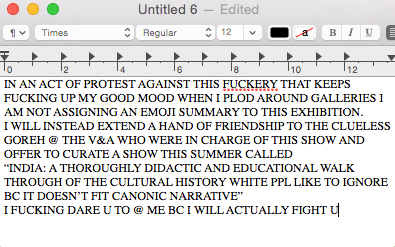Fabrics of India
ZM
Once every few years one museum or the other needs to fill its diversity quota and an exhibition like this comes around that's like "INDIA…" and my Mum always says we should go, and we always do. And we get fancy coffee and hold hands on the tube and it's a lovely day out like when I was little and I wanted to lick all the paintings in the National Gallery.
But.
As I've got older, either I've become more cynical or I've noticed a similarity or cohesive narrative surrounding the mystical, exotic East (capitalised for sarcasm. Not complicity.) I have a real problem with representation and India. It seems these exhibitions focus on things they know aren't too perplexing or challenging for the middle aged white ppl who flock to this shit. And it problematises it, because it reduces the East (a fucking HUGE place) to a group of homogenised signifiers, typified by Occident/Orient dichotomies and preconceptions of what we think should be there, not what actually is there. It becomes an exercise of the imagination, the East as an ideal not a factual territory.
I don’t know if it’s just me that gets pissed off at this; there is so much focus on the East as a master at artisanal production, but not capable of producing cultural items beyond the visually or aesthetically (or implictly technically) pleasing. In this exhibition India is represented as a mystical land spanning from Balochistan to Kathmandu (both NOT in modern India) with a population of craftsmen capable of outstanding technical ability. A land of LuXuRy and spiritual awareness beyond us, the mere mortal (but available for a price, normally paid to the white girl in yoga pants). But ultimately, in this exhibition, India’s cultural products are rendered as chintzy novelty Folk art. The wall blurbs were awful and my Mum read every single one, but by the end even she was sniggering. It felt grotesque, peering in to vitrines at scraps of fabric (however beautiful) listening to some woman called Margret complaining to her stupid long haired husband about how fucking barbaric it was that the Qur'an says men can't wear silk on their skin. (The exact quote was "another fucking stupid rule. They're barbaric.")
Honestly, I went in to this show hoping it would be different, I wanted to love it. As me and my mum walked round, I saw other brown girls my age there with their mums. I saw old Indian masis there with their daughters, their sons. Whole fucking brown families. And I nearly fucking cried. Because the V&A had command of a group of people that typically don’t really visit galleries all that often. They had shown up and the V&A had cocked up a really amazing chance to show them a cultural heritage that is by and large brushed under the carpet by Western institutions. Indian painting is either forgotten or only remembered as primitive wall art, classed in the same category as the pyramids and cave paintings. They are veiwed as a long-fucking-time ago. There is no NO recognition of Indian contributions to the history of painting. Post modernism was HHUGGE in India, where is that history?
This exhibition, however trite I am about it, will pop up again in 2017 or something. Because it is symptomatic of a greater problem in the West's cultural relationship with the East. I have never ever eVER seen a show like this that dealt with Eastern artists as intellectually equal or even independent from the West. There is a rift between Occidental expectation of the Orient and reality. Because the truth is that artists in India have been dealing with the same philosophically and theoretically rich subjects that European artists have the capacity to; but their efforts are erased, unrecognised and flattened. Focus is instead drawn to that which is easier to understand, it's not like India's relationship with fabric is simply only decorative or technical (or even briefly devotional). The East is represented as negatively defined by the space inhabited by the Occident and as a result, the capacity for depth of understanding is flattened.
I sit waiting patiently for a show discussing the intricacies of Post-Modernist painting in India. I sit waiting patiently for a show that explores how key Indian directors were in the early international history of Film (don't start me on early Bolly history). I sit waiting patiently for a retrospective of the amazingly subversive moving image work from the Delhi schools in the 50s, a movement comprised of almost as many women as men (hugely important and overlooked). I sit waiting patiently for Amrita Shergil's paintings to be more famous than Gaugin's or for Nalini Malani and her installation work to be recognised as the influential force they deserve to be. I sit waiting for all these things and they never fucking arrive. Because the relationship between east and west is flawed. Power flows unilaterally STILL. 2 years ago I went to a show at the V&A of several of MF Husain's triptychs. They were beautifully painted, the narrative heir spun was complex and they were unapologetically didactic. And the press release described them as "Indian subject matter in Western European style". Like the West can rob the East and call it innovation or modernity, but the other way round is copying or mimicry, a sign of a culture incapable of complex artistic output. This shit is flawed and we need to collectively re-fucking-assess our fucking mindsets.
Another note:
There was not one fucking mention of the role fabric played in the birth of India as a modern nation. Only a brief reference to the Swadeshi movement under a picture of Nehru as a sidebar while talking about Nehru collars. Not one fucking mention that the British trading companies committed numerous war crimes and brutalised thousands of Bengali weavers, cutting off their thumbs so mechanically woven fabric from British industrial towns could be sold in a market place they dominated by force. The political relationship between Ancient India and cloth was skimmed over as well as the historically key role the fabric trade played in how British rule over most of South Asia came about. (Actually and how it was resisted, yet again the Swadeshi movement should have had more fucking acknowledgement.)
Yet another fucking note:
My Mum was very very angry about the prices in the gift shop. There's a traditionally Gujarati embroidered door hanging and they're heavily worked with mirrors and Kutchi style hand embroidery. She got really angry because one was being sold for £450 and she asked the woman in the gift shop why; she said "because it's hand embroidered". And my mum said “but they’re all hand-embroidered???” and she made a point to go round the gift shop and tell every single gora there that you can get all the stuff they had on sale in that gift shop for a fraction of the price in Wembley. It’s a fair point. The V&A were hugely marking up a cultural item that belongs to a specific minority group. It’s only fair my mum went round and told everyone we got ours in Rajkot for the equivalent of probably £3, and it was much nicer and looked less tatty.


